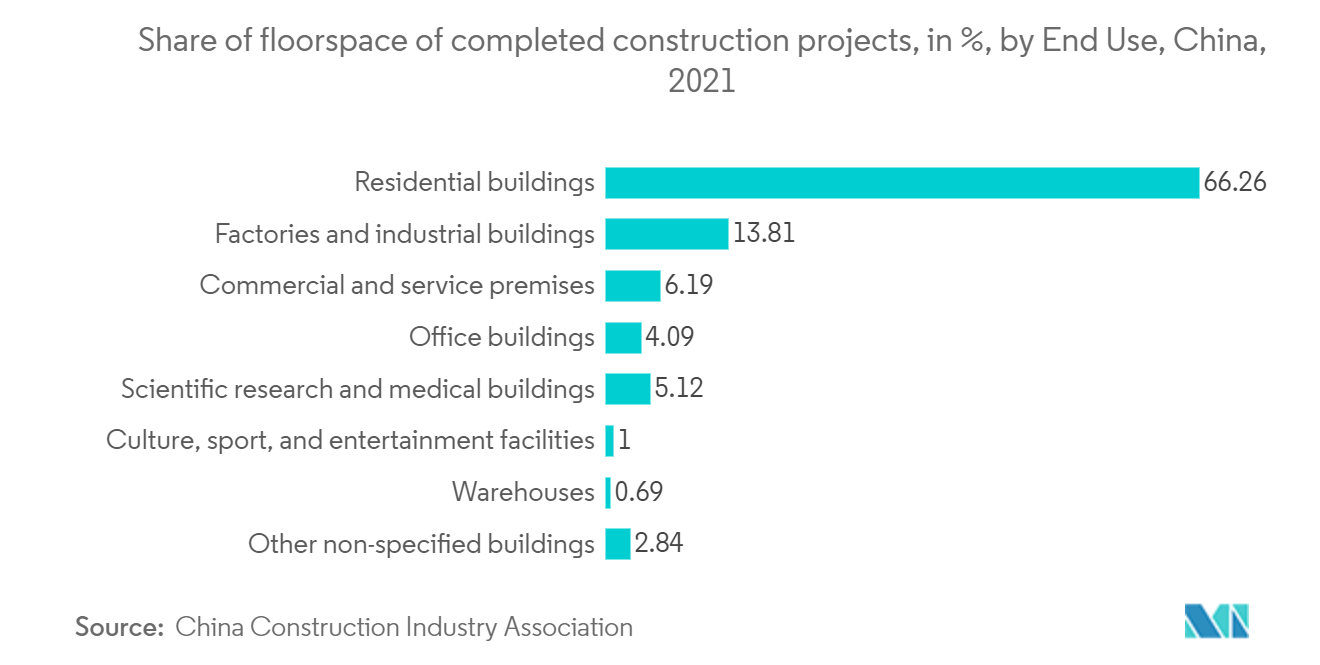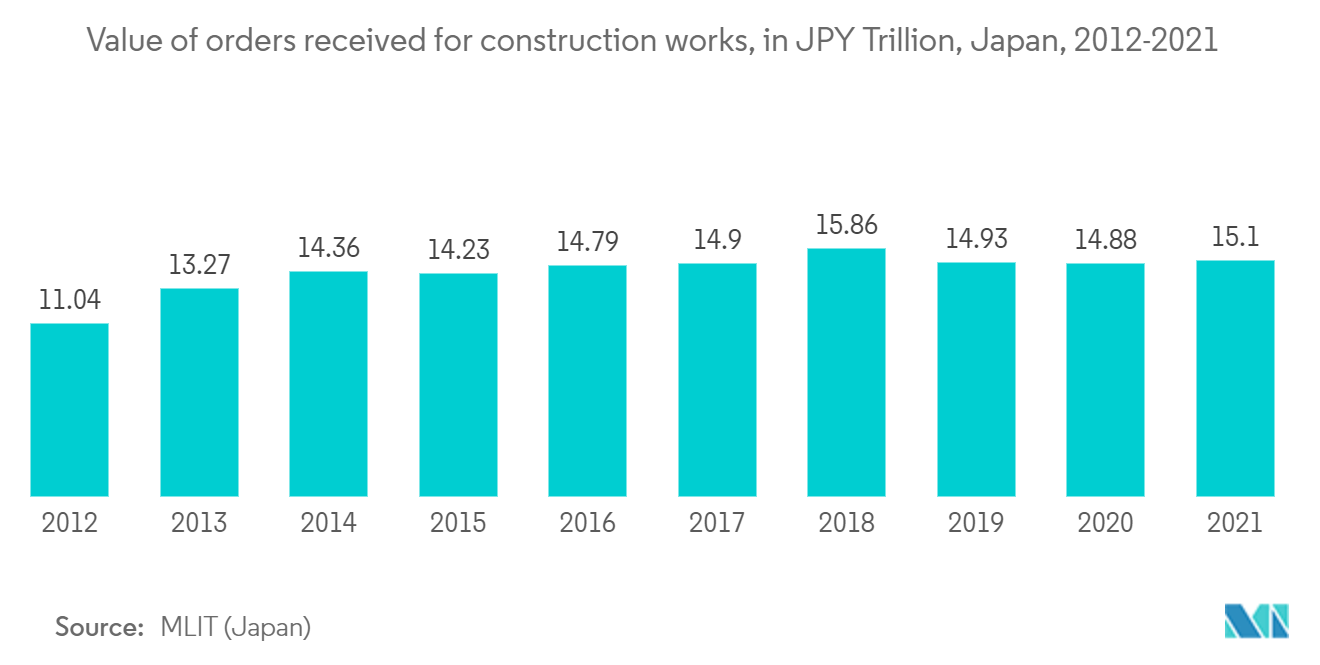Market Trends of APAC Building Energy Management Systems Industry
This section covers the major market trends shaping the APAC Building Energy Management Systems Market according to our research experts:
The Increase in Demand from the Residential Segment is Expected to Drive the Market
- According to China Construction Industry Association, Residential buildings accounted for the largest share of completed construction in China in 2021. Buildings intended for housing accounted for over 67% of the finished floor space. As the country's economy grows, people migrate from rural areas to major cities, increasing demand for residential accommodation in these locations. Furthermore, apartments utilized as investment properties drive up demand. Such a large share of residential buildings would create an opportunity for the market players to develop new products to cater to a wide range of needs of customers.
- Further, according to Housing & Development Board, In the fiscal year 2021/2022, the Housing Development Board in Singapore has 83 thousand residential units under construction. In comparison to the previous year, demand for HDB units had grown.
- Innovative technologies often incentivized through prescriptive utility energy efficiency programs include advanced occupancy and vacancy controls that work with lighting and HVAC systems, daylighting controls, intelligent power strips, smart plugs, and BMS. The Government of India developed 'The Energy Conservation Building Code' (ECBC), which sets minimum energy performance standards for residents and includes the building envelope, heating, ventilation, and air conditioning. Hence, the growing adoption of smart lighting systems could help the country save energy.
- To cater to the evolving needs of consumers, in April 2022, ABB and Samsung Electronics announced that they would collaborate in a global partnership to provide jointly developed technologies for energy management, energy savings, and the smart Internet of Things connection of residential and commercial buildings. As per the companies, buildings generate almost 40% of annual global CO2 emissions. The partnership would create a platform to build a long-term relationship for innovation on smart technology, smart control, and smart devices. The collaboration would enable Samsung and ABB to expand customer access to home automation technologies and better device management while facilitating electricity load shifting.
- Building Energy Efficiency has become a global priority. In Australia, the National Construction Code now includes energy efficiency measures for all building classifications. The National Australian Built Environment Rating System (NABERS) allocates a 0-6 star rating to a building's greenhouse performance and resource efficiency. All Government departments and many businesses are leading the push for more sustainable built environments by no longer taking residency in buildings under 4.5 stars.

Japan is Expected to Witness a High Market Growth
- The rise in the number of construction orders in the region would create several opportunities for the growth of the studied market. For instance, according to MLIT (Japan), the value of orders for building works received by 50 major Japanese constructors in the fiscal year 2021 was around JPY 15.1 trillion (USD 0.11 trillion), marking a 1.5 % increase over fiscal 2020.
- The region also boasts several laws and regulations regarding energy efficiency that are likely to boost the growth of the studied market. For instance, the National Energy Conservation Law includes building energy requirements in Japan. Various provisions of the Energy Conservation Law pertain to the building sector, such as Criteria for Clients on the Rationalization of Energy Use for Buildings and Design and Construction Guidelines on the Rationalization of Energy Use for Houses. The first relates to non-residential buildings, whereas the second applies to residential buildings. Although these rules are designated as voluntary, several components are enforced. For example, building owners must submit a report on energy conservation measures before new construction, extension, alteration, and significant renovations, which must be reviewed and approved.
- Further, in April 2022, the Bill for the Partial Revision of the Law Concerning the Improvement of Energy Consumption Performance of Buildings to Contribute to the Realization of a Decarbonized Society was adopted by Japan's Cabinet. The law accelerates energy-saving building measures to attain carbon neutrality by 2050 and a 46% decrease in greenhouse gas emissions by 2030 compared to 2013 levels. Energy conservation standards, which are currently restricted to non-residential buildings with a floor area of 300 square meters or more, will become mandatory for all new residential and non-residential buildings beginning in 2025.
- Smart cities in Japan are gradually growing across several prefectures, with progressively more companies joining the Smart City Institute Japan, a non-profit organization that connects sectors engaged in developing smart cities in Japan. Smart cities like Kashiwa-no-ha and Fujisawa are encouraging other investors from Japan and the rest of the world to understand the importance of a smarter future. The robust smart city ecosystem in the nation is anticipated to drive the market's growth.
- Moreover, to cater to the complex demands of consumers, several companies in the region are launching new and advanced products & platforms and collaborating with various organizations to extend their geographic reach. For instance, in December 2021, GE Grid Solutions and Fujitsu announced a partnership to sell GE's EnergyAPM asset performance management solutions in Japan. GE's EnergyAPM, which is designed exclusively for grid electrical assets, assists T&D operators and industrials in developing an intelligent performance plan for managing electrical substations and equipment. EnergyAPM's package of software services improves operational reliability while lowering the total cost of ownership by combining asset data with industry expertise, analytics, and connectivity.


